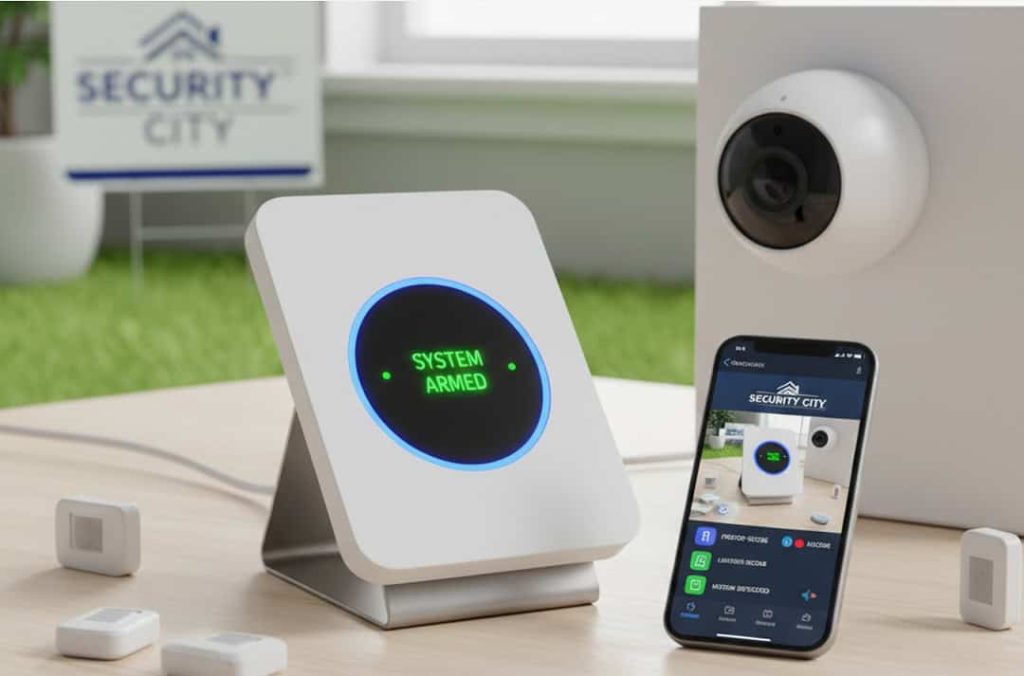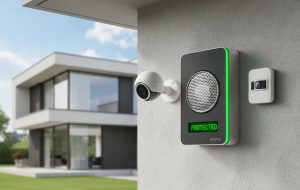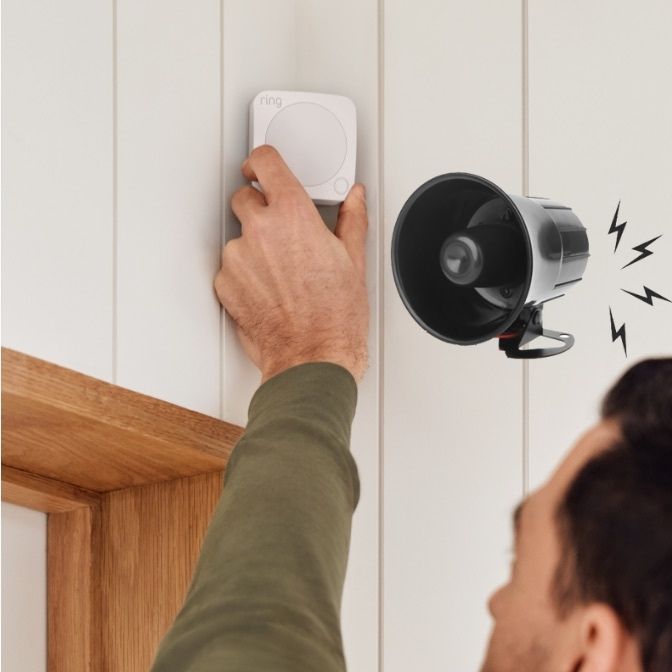When it comes to home security, door locks and surveillance cameras often get all the attention. But what happens when an intruder bypasses those initial defenses, or when a fire breaks out, or a pipe bursts? This is where a robust home security siren and alarm system becomes your home’s vigilant guardian and immediate responder.
In 2025, alarm systems are smarter, more integrated, and more essential than ever. They are no longer just noisy boxes designed to scare off burglars; they are sophisticated networks of sensors, deterrents, and communication hubs that offer comprehensive protection against a wide range of threats.
This guide will demystify home security sirens and alarm systems, breaking down their essential components, explaining how they work, comparing different types, and highlighting key features to look for in 2025 to ensure your home has ultimate, stress-free protection.
Beyond the “Noise”: Understanding the Modern Alarm System
Many people equate a “siren” with just a loud sound. While an audible alarm is a critical component, a modern home security system is a complete ecosystem designed to detect, deter, and notify. It’s a proactive shield, not just a reactive noisemaker.
What Makes Up a Comprehensive Home Alarm System?

A robust home security system integrates multiple components that work in concert to create layers of protection. While specific kits may vary, most comprehensive systems include:
- 1. Control Panel/Base Station: This is the “brain” of your system. It’s a central computer that communicates with all sensors, processes information, arms/disarms the system, and relays alerts. It often has a keypad for manual input and can be a touchscreen, physical panel, or a discreet hub.
- 2. Keypads: User interfaces (physical or virtual) for arming, disarming, and managing the system. Can be mounted by entryways or accessed via a smartphone app.
- 3. Entry Sensors: Small, two-part devices installed on doors and windows. They detect when an entry point is opened, breaking an electrical or magnetic circuit.
- 4. Motion Detectors: Use infrared or microwave technology to sense movement within a defined area, protecting larger spaces.
- 5. Glass Break Sensors: Acoustic sensors that listen for the specific sound frequency of breaking glass.
- 6. Security Cameras: Both indoor and outdoor cameras provide visual verification and surveillance. (Note: While cameras are part of a full security system, the siren/alarm system is primarily about detection and notification).
- 7. Sirens: The audible alarm component, designed to deter intruders and alert occupants and neighbors. Can be built into the base station or be a separate, more powerful outdoor siren.
- 8. Environmental Sensors: Modern systems often integrate detectors for smoke, carbon monoxide, water leaks, and extreme temperatures.
- 9. Range Extenders/Repeaters: For larger homes, these boost the wireless signal between components and the base station.
- 10. Monitoring Service (Optional): A 24/7 professional monitoring center that receives alerts from your system and dispatches emergency services if needed.
How an Alarm System Works (The Cycle of Protection)
- Arming: You activate the system via a keypad, smartphone app, key fob, or voice command. Depending on the mode (e.g., “Away” or “Home”), different sensors are activated.
- Detection: A sensor is triggered (e.g., a door opens, motion is detected, or smoke is sensed).
- Alarm & Verification (Optional): The control panel initiates an alarm.
- Audible Siren: A loud alarm sounds, designed to scare off intruders and alert occupants/neighbors.
- Silent Alarm: In some scenarios (e.g., medical emergency, panic button), a silent alert can be sent to monitoring.
- Video Verification: If cameras are integrated, the system or monitoring center can quickly review footage to confirm an actual event and reduce false alarms.
- Notification:
- Self-Monitoring: Alerts are sent directly to your smartphone via push notifications, email, or text. It’s then your responsibility to assess and contact authorities.
- Professional Monitoring: The control panel sends a signal to a 24/7 monitoring center. Trained operators verify the alarm and then dispatch police, fire, or medical services as needed, often contacting you first.
- Disarming: You deactivate the system using a code, app, or key fob.
Wireless vs. Wired Alarm Systems: The 2025 Debate
The choice between wireless and wired alarm systems is fundamental and depends heavily on your property, budget, and DIY comfort level.
Wireless Alarm Systems (The Modern Standard)
How They Work: Components communicate with the base station using radio frequencies (Wi-Fi, Z-Wave, Zigbee, Bluetooth). They are battery-powered (sensors) or plug-in (base station, keypads).
Benefits:
- Easy DIY Installation: No drilling or complex wiring required. Ideal for renters or those who want to avoid professional installation costs.
- Flexibility & Portability: Components can be easily moved, added, or removed. Great for adapting to layout changes or taking with you if you move.
- Clean Aesthetics: No unsightly wires running along walls.
- Smart Home Integration: Often designed from the ground up to integrate seamlessly with smart home platforms and apps.
- Battery Backup: Sensors run on batteries, ensuring continuous operation even during power outages (though the base station often needs a backup battery as well). Low battery alerts are typically sent to your phone.
Downsides:
- Battery Dependence: Requires periodic battery replacement for sensors.
- Potential for Interference: Wireless signals can be susceptible to interference from other devices or deliberate jamming (though modern systems use encrypted, frequency-hopping technology to mitigate this).
- Range Limitations: Larger homes may require range extenders to ensure all components communicate effectively.
Wired Alarm Systems (The Traditional Powerhouse)
How They Work: Each component (sensors, keypads) is physically connected to the control panel via low-voltage wiring run through walls and ceilings. Power is often supplied via these wires.
Benefits:
- Maximum Reliability: Extremely resistant to signal interference or jamming, as all communications are hardwired.
- No Battery Changes (for wired sensors): Components draw power directly from the main system, ensuring constant operation.
- Robust Security: Often chosen for high-security applications due to their physical connections.
- Long Lifespan: With proper installation, wired systems are incredibly durable and long-lasting.
Downsides:
- Complex Professional Installation: Requires extensive drilling and cabling, making professional installation almost mandatory.
- High Upfront Cost: Equipment cost combined with significant installation labor makes them more expensive initially.
- Less Flexible: Difficult to move or reconfigure once installed. Not suitable for renters.
- Aesthetics: Can be challenging to hide all wiring discreetly.
Key Features to Prioritize in Your 2025 Home Security Siren System

When selecting an alarm system, look beyond the basic siren. Modern systems offer powerful features that enhance protection and convenience.
1. 24/7 Professional Monitoring
While self-monitoring (receiving alerts on your phone) is an option, professional monitoring is the gold standard for protection. A dedicated team is always watching, ensuring emergency services are dispatched even if you’re unreachable or unable to respond. Companies like SimpliSafe, Vivint, and Ring Alarm offer excellent professional monitoring services.
2. Cellular Backup
Crucial for reliable communication. If your internet goes down or a power outage affects your Wi-Fi router, a cellular backup ensures your alarm system can still send alerts to the monitoring center or your phone. This is a non-negotiable feature for serious home security.
3. Environmental Monitoring
Beyond intruders, modern systems detect other threats:
- Smoke/Carbon Monoxide (CO) Detectors: Integrate these directly into your alarm system for instant alerts and professional dispatch.
- Water Leak Detectors: Place these in basements, near water heaters, or under sinks to prevent costly water damage.
- Freeze Sensors: Alert you if temperatures drop too low, preventing burst pipes.
4. Smart Home Integration
Your alarm system should seamlessly connect with your other smart devices.
- Voice Control: Arm/disarm your system with Alexa or Google Assistant.
- Automations: Link with smart lights (flash when alarm sounds), smart locks (lock automatically when armed), or smart thermostats.
- App Control: A well-designed smartphone app is essential for remote arming/disarming, checking status, viewing activity logs, and managing settings.
Learn more about Security Systems
